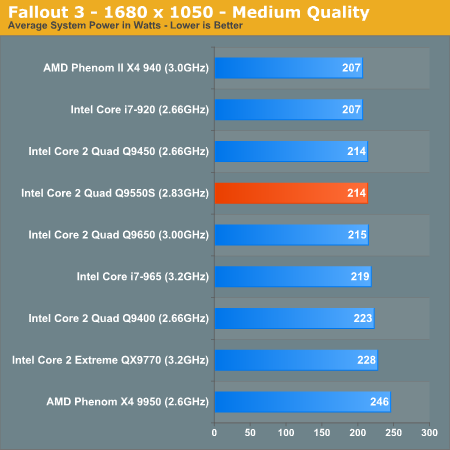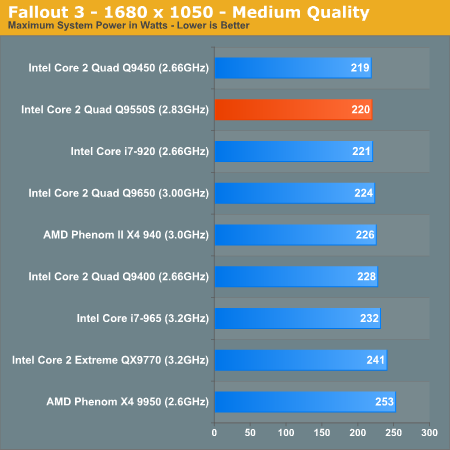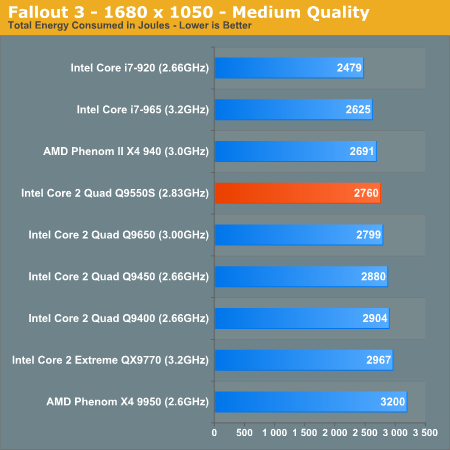Intel Core 2 Quad Q9550S: A New 65W Quad-Core
by Anand Lal Shimpi on January 27, 2009 8:00 PM EST- Posted in
- CPUs
Fallout 3 Game Performance
Bethesda’s latest game uses an updated version of the Gamebryo engine (Oblivion). This benchmark takes place immediately outside Vault 101. The character walks away from the vault through the Springvale ruins. The benchmark is measured manually using FRAPS.

Gaming performance here is pretty well clustered around the mid 80s.

With the GPU being the big driver of power consumption here, the CPUs themselves all use a similar amount of power. The variance between similarly clocked CPUs is normal between runs.
Peak power tells a similar story:


The energy efficiency graph is, however, unexpected. The Fallout 3 benchmark is a fixed time test; in other words, it takes the same amount of time to complete regardless of the system. With all benchmarks taking the same amount of time, total energy consumed should be dependent solely on average power. We’ve already seen that average power is pretty similar between the systems, so we should see some pretty even results here right?
Wrong.
While all of the Core 2 Quads consumed around 2800 - 2900J of energy the Core i7s used 2625J and 2479J for the 965 and 920, respectively. Remember that a feature of Core i7 is the ability to completely cut power to one of the cores if it’s not being used. This feature is thanks to Intel’s power gate transistors, which aren’t used in the Core 2 Quads. In a game where all four cores aren’t taxed, Core i7 can pull ahead in energy efficiency despite using a similar amount of power to the rest of the contenders.
The i7-920 actually uses less energy in this test than the lowest power quad-core Penryn we have on the chart.










62 Comments
View All Comments
strikeback03 - Wednesday, January 28, 2009 - link
Far and away the most cost efficient thing for those like you who only care about games is to stick with your dual core, followed by getting a faster dual-core or an SSD. Check the performance numbers in the Phenom II launch article, as most of the games are not using the quad-cores, very few of them look good in added performance for the money.WillR - Wednesday, January 28, 2009 - link
What it really boils down to is "which socket do you already have?". And Intel knows this. Think about it, they've been beating AMD pretty much since the C2D's came out so most people adopted that platform and already own Socket T/775 boards with C2D chips. Now that AMD has released a competing 45nm quad core, Intel has had to lower their prices to attract purchases of customers they already had. The decision for many people (including yourself) is do you spend $280 on a new Q9550 or $195 for a new P2 920 and another $100-150 on a new motherboard that will make it work? Clearly the almost $300 CPU is the cheaper option. And I'd bet most will go for the Q8200 or the Q9400. "Most" being the average consumer that buys it and gets someone else to install it for them. Intel would be silly not to get another $85, or even the $35 for the Q9400, out of customers that are upgrading from Core2Duo's. IMO, it's worth it just to avoid the hassle of changing 2 pieces of hardware at 1 time. That's a major headache if one of the parts is DOA.The only place Intel can lose business (in reference to quad cores) to AMD right now is people buying Phenom 9600s for $110 that want a quad core "just because", to people that already have an AM2 platform, AMD fanbois, and people that have not bothered to upgrade their 2Ghz P4 yet. And those last aren't going to go with AMD because they think AMD parts are cheap for a reason. There are many people that just won't buy from tech companies like AMD because they consider them "second rate" businesses with low quality products, even though they've never owned anything they make.
plonk420 - Tuesday, January 27, 2009 - link
what build of x264 was this?i'm assuming this build was downloaded via MeGUI and its updater...
Jedi2155 - Tuesday, January 27, 2009 - link
Have we really become that? I didn't think there ever wood be high volume enthusiasts.hansmuff - Tuesday, January 27, 2009 - link
I was hoping to get some information about how the chip overclocks and if there are significant differences between it and the non-S cores in terms of overclocking.Anything the author can add?
B3an - Tuesday, January 27, 2009 - link
Exactly, thats what nearly all of us care about. Such an OBVIOUS thing to have in the article.Anand Lal Shimpi - Tuesday, January 27, 2009 - link
The Q9550S didn't overclock any better than our other Q9550 that we used in the overclocking section in the Phenom II review.-A
Giant Panda - Tuesday, January 27, 2009 - link
You people really need to read before you post. At the bottom of page one the author states and I quote "...and in case you’re wondering, no, they don’t overclock any better. Our Q9550S couldn’t get any further than the Q9550 we used in our Phenom II review." If you aren't going to even bother reading the article why do you bother to post and ask questions that were answered in the article you clearly didn't even read?Ryun - Tuesday, January 27, 2009 - link
In the Photoshop tests I'm assuming you calculated joules by multiplying the time it took to complete the test by the average system wattage drawn from the wall. If that is the case the Phenom II 940 joules should be closer to about 3800 joules (24.2sec * 157watts) and not the 4700 joules you have listed.Please correct me if I am mistaken.
Anand Lal Shimpi - Tuesday, January 27, 2009 - link
I actually took the system power every second during the test and summed that. The numbers are close, but not identical.-A